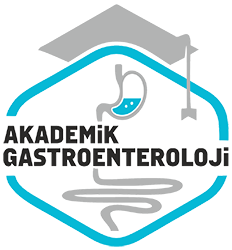Serum seruloplazmin düzeyi: Wilson hastalığında selatör tedaviden etkileniyor mu? Aile taramasinda değeri nedir?
Serum ceruloplasmin levels in Wilson disease: Diagnostic value and the effect of chelation therapy
- Ana Sayfa
- Sayılar
- Serum seruloplazmin düzeyi: Wilson hastalığında selatör tedaviden etkileniyor mu? Aile taramasinda değeri nedir?...
Özet
Giriş ve amaç: Serum seruloplazmini, akut faz reaktanlarindan biridir. Bu durum, özellikle hepatik formdaki Wilson hastalığı tanısında, serum seruloplazmin düzeyinin kullanımini zorlastirir. Ayni zamanda selatör tedavi sırasında serum düzeylerinde azalma da görülebilir. Gereç ve yöntem: Bu çalışmada 34 Wilson hastasında (15 hepatik, 6 nöropsikiyatrik, 4 hepatonörolojik ve 9 asemptomatik) baslangiç seruloplazmin seviyesinin tanıda değeri ve tedavi seyrindeki degisıklıkleri değerlendirilmıştır. Serulopazmin seviyesi radyal immunodiffüzyon teknigi ile, baslangiçta ve selatör tedavinin en az 6. ayindan sonra ölçülmüstür. Hastaların ortalama yaşi 20±9.6 yıl (7-46 yıl) ve ortalama takip süresi 36±25 ay (6-75 ay) idi. Bulgular: Tüm grupta, tedavi öncesi düşük serum seruloplazmin seviyesi (< 20 mg/dl) %76.5 (26 hasta) ve ortalama serum seruloplasmin düzeyi 13.1±6.8 mg /dl (3.2-26.9 mg/dl) idi. Tedavi seyrinde, düşük serum seruloplasmin düzeyi Hastaların % 94’ünde (32 hasta, p=0.421) ve ortalama serum seruloplazmin düzeyi 9.4±4.4mg /dl (3-23.9, p< 0.003) idi, anlamli azalmisti. Serum seruloplazmin düzeyi 7 hastada (3 hepatik, 2 hepatonörolojik, 2 asemptomatik) anlamli azalirken sadece 1 hastada (hepatik form) anlamli olarak artti. Sonuç: Bu sonuçlarla, düşük serum seruloplazmin düzeyi Wilson hastalığı tanısı ve aile taramasında en iyi testlerden biri olmasina ragmen, normal serum seruloplazmin düzeyi tanıyi ekarte ettirmez. Bu Hastaların çogunda selatör tedavi seyrinde seruloplazmin düzeyleri anlamli olarak azalmaktadır. tanı aşamasinda, serum seruloplazmin düzeyi normal ise, süpheli vakalarda bozulmus bakir metabolizmasinin göstergesi diğer bir test ile yapilmalidir.
Abstract
Background and aims: Serum ceruloplasmin level is an acute phase reactant. It may be difficult to determine its value in the diagnosis of Wilson’s disease, especially in the hepatic form and serum ceruloplasmin levels may be decreased by chelation therapy. The aim of this study was to determine its diagnostic value and to evaluate whether there is a change in serum ceruloplasmin level with chelation therapy. Materials and methods: Serum ceruloplasmin levels of 34 patients with Wilson’s disease (15 hepatic, six neurologic, four hepatoneurologic and nine asymptomatic) were measured by radial immunodiffusion at the time of diagnosis and at least six months after the beginning of therapy. The mean age at diagnosis was 20±1.65 years (range 7-46 years) and the mean duration of follow-up was 45.2±43.8 months (range, 6-75 months). Results:In the whole group, a low serum ceruloplasmin level (< 20 mg/dl) was found in 76.5 % (26) of patients and the mean serum ceruloplasmin levels were 13.1±6.8 mg /dl (range, 3.2-26.9 mg/dl) at baseline. However, low serum ceruloplasmin level was found in 94% (32, p=0.421) of patients and mean serum ceruloplasmin levels were decreased to 9.4±4.4mg /dl (range; 3-23.9, p< 0.003) during therapy. The serum ceruloplasmin level was decreased in seven pts (three hepatic, two hepatoneurologic and too asymptomatic) and only one low serum ceruloplasmin level increased during therapy. Conclusions: Although determination of the serum ceruloplasmin level is suggested to be the most useful screening test for Wilson’s disease, a normal serum ceruloplasmin level does not exclude the disease. Serum ceruloplasmin levels in such patients may be decreased during chelation therapy. Even if the serum ceruloplasmin level is normal at the time of diagnosis other laboratory parameters suggestive of impaired copper metabolism should be evaluated in patients with a suspected diagnosis Wilson’s disease.



